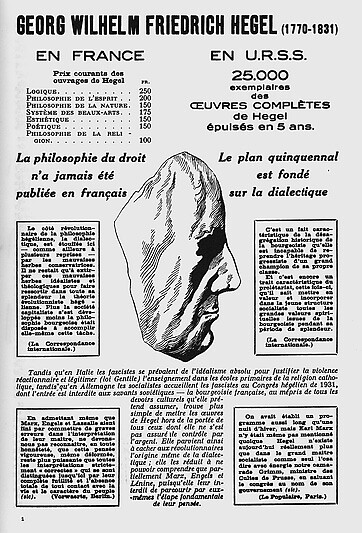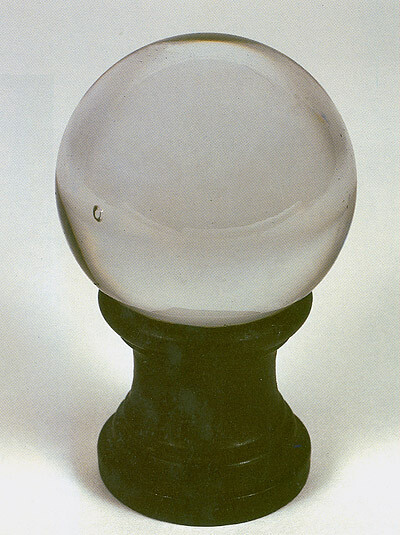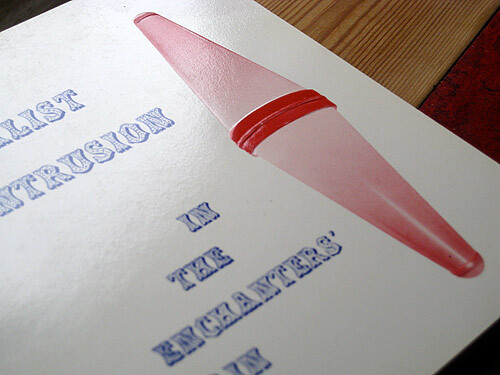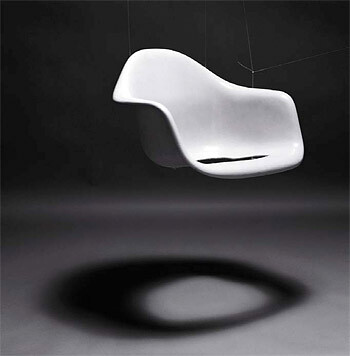In modern art, the increasing resemblance of art objects to everyday objects raised the threat of eroding of any real difference between works of art and other things. Barnett Newman railed against both Duchamp’s readymades and “Bauhaus screwdriver designers” who were elevated to the ranks of artists by the Museum of Modern Art’s doctrine of “Good Design.” 1 The danger for art was the same in both cases: the dissolving of the dividing line between works of art and everyday objects. Just as ancient art proper should never be confused with the craft of “women basket weavers,” modern art should never be confused with a screwdriver or urinal. 2 In the 1960s, Clement Greenberg would also worry that a blank sheet of paper or a table would become readable as art, that the boundary between artworks and “arbitrary objects” was eroding. 3 While not evincing any Modernist anxieties about readymades, Paul Chan’s recent assertion that “a work of art is both more and less than a thing” shows renewed concerns regarding such an assimilation—in a context marked, until quite recently, by an unprecedented market boom in which works of art seemed to be situated in a continuum of luxury goods spanning from Prada bags to luxury yachts. 4
But what does it mean to say that an artwork is both more and less than a thing? The notion of the thing is prominent in contemporary theory, and one might say that the thing has emerged as something that is both more and less than an object. In W. J. T. Mitchell’s words:
“Things” are no longer passively waiting for a concept, theory, or sovereign subject to arrange them in ordered ranks of objecthood. “The Thing” rears its head—a rough beast or sci-fi monster, a repressed returnee, an obdurate materiality, a stumbling block, and an object lesson. 5
Rather than building a wall between art and thingness, the work of art should be analyzed as just such a sci-fi monster. If objects are named and categorized, part of a system of objects, thingness is resistant to such ordered objecthood. If we grant that a work of art is both more and less than other types of things, this should not be regarded as an incentive to exacerbate and fetishize those differences, but rather as a point of departure for analyzing the complex interrelationships of artworks with these other things—and for examining certain works of art as problematizing and transforming this very relationship. 6


A prominent proponent of the thing in recent theory is Bruno Latour, who has taken it upon himself to reveal “the terrible flaws of dualism,” which marked modernity. 7 The hubristic project of modernity was based on the dichotomy of society and nature, of subject and object; this enables the modern “work of purification,” the triumph of the subject and the relegation of nature and of non-moderns to the abyss of thought. Underneath this purifying dichotomy, however, there is a disavowed continuity of networks, of hybrids; modern binary, “critical” thinking exists by virtue of the denial of this continuity, this world of “quasi-objects” and “quasi-subjects”—that which is “between and below the two poles” of object and subject. 8 “Moderns do differ from premoderns by this single trait: they refuse to conceptualize quasi-objects as such. In their eyes, hybrids present the horror that must be avoided at all costs by a ceaseless, even maniacal purification.” 9
Like all good caricatures, Latour’s portrayal of modernity presents some traits in sharp, even exaggerated clarity. And like many good and bad caricatures, it is one-sided and self-serving. If we look carefully at modern theory and (art) practice, it should be obvious that there have been a number of significant attempts to go beyond a static dichotomy of subject and object. Reexamining such moments can be of extreme interest—not in order to create some kind of oneiric ancestral line leading up to present concerns, but in order to sound out the limitations as well as the unfulfilled potential of various practices. Working though the contradictions of, for instance, the Duchampian readymade can help focus current debates—turning such a historical phenomenon into an anachronistic intervention in the present.
The rejection of the readymade by critics and artists such as Greenberg and Newman was shaped by a fear of the collapse of categories, the fear of identity, of the work of art becoming just another “arbitrary” object. In addition to such critiques, which we may label conservative, the 1960s saw the emergence of a second strand of anti-Duchampian discourse. Its proponents were artists including Dan Graham, Robert Smithson, and Daniel Buren, and an important point that their different criticisms had in common was that Duchamp’s own practice was itself conservative in that it merely seemed to confirm and exploit the existing art-world structures and their power of definition.10 Apparently working on the assumption that Duchamp’s work was fully accounted for by the then-emerging institutional theory of art, these artists felt that Duchamp merely used the institution(s) of art to redefine objects as artworks, thus multiplying their aura, their fetishistic allure, and their value. As Robert Smithson put it, “there is no viable dialectic in Duchamp because he is only trading on the alienated object and bestowing on this object a kind of mystification.” 11
Such remarks were no doubt made in view of Duchamp’s own commodification of his readymades in the 1960s, with the Schwartz editions, and of the proliferation of Neo-Dada and Nouveau Réalisme objects, accumulations, and assemblages. This type of art object was tailor-made for the dismal science called the institutional theory of art, which it helped spawn, and which statements by artists such as Buren and Smithson parallel. However, if we look beyond the horizon of the 1960s reception of Duchamp, at the repercussions of the readymade among the Surrealists around 1930 in particular, things become rather more complicated and interesting.


Hegel saw modern art as bifurcating into on the one hand a “realist” tendency that would show the surface of objects in minute “objectivity,” and on the other a “spiritual” tendency that would place all the emphasis on the subject. 12 For the Surrealists, Duchamp’s readymades became crucial at the moment when the question of the relation between subject and object, between spirit and matter, became an overriding concern: when they placed their activities “in the service of the revolution,” entering into a difficult relationship with the party that claimed to represent and enact dialectical materialism, and which eyed the Surrealists’ idealist focus on dreams and visions more than a little suspiciously. The Surrealists set out to prove that their approach in fact complemented orthodox Marxism, in that Surrealism, “within the framework of dialectical materialism, is the only method that accounts for the real links between the world and thought.”13 If dialectical materialism can cause bricks to be laid, then surely this relationship was of primary importance. 14
One of the issues of Le Surréalisme au service de la révolution contained a montage of textual fragments on Hegel and Marx, which contrasted the lackluster number of Hegel’s works available in French with the blockbuster sales of Hegel’s complete works in the Soviet Union, informing us that “the five year plan is founded on dialectics.” 15 In the middle of a page is a line drawing of Hegel’s death mask; Spirit has become plaster. If the facts about the prices and sales of Hegel’s works seem to fit into Aragon’s quite linear remarks on spirit influencing things in the world, the death mask complicates things. As an outmoded relic of the nineteenth century, it is a Surrealist object par excellence, but it is hardly operative in the contemporary world—unless one instrumentalizes it for the purpose of some Stalinist personality cult.
To some extent, the Surrealist art of the object represented an appropriation, a détournement of Duchamp’s project. Surrealist objects were supposed to provide shocks, to give the viewer a jolt, which sets them apart from Duchamp’s more “disinterested” montages of existing objects and new thoughts. What the Surrealists saw very clearly, however, is that the Duchampian readymade was, in David Joselit’s words, “a paradoxical object locked in a perpetual oscillation between its status as a thing and its status as a sign.” 16 The bottle rack—sometimes called Hedgehog—inscribed with Duchamp’s signature becomes its own double, a visual pun combining Duchamp’s favorite “ism,” eroticism (the phallic protrusions), with references to his arcane geometric and n-dimensional concerns. 17 Outwardly, the object remains the same, yet it is dislodged, integrated into the web of signification spun in Duchamp’s notes.


When André Breton’s estate was auctioned off, one of the items for sale was a semiotic object par excellence: a fortune teller’s crystal ball that had been used in 1933 to illustrate Breton’s text “Le Message automatique.” 18 In his 1925 “Lettre aux voyantes,” Breton had addressed the fortune-tellers, or “seers,” who had been marginalized by modern science:
Mesdames, today my mind is wholly on your disgrace. I know that you no longer dare to use your voice, no longer deign to use your all-powerful authority except within the woeful “legal” limits. I can see in my mind’s eye the houses you live in, on the fourth floor, in districts more or less remote from the cities. 19
Breton pleads with the “ladies” that it is time for them to give up their passivity and reclaim their proper role. The crystal ball, smaller than one would expect on the basis of cartoons and comic strips, speaks of the same ambiguity between exalted visions and the banality of banlieue fortune-telling. An exemplary visual object or object-sign, the crystal ball was at the same time a materialization of desire and a dematerialization of the object; a proper Surrealist thing.
The last major Surrealist exhibition, “Surrealist Intrusion in the Enchanters’ Domain,” which took place in New York in 1960, was also the last collaboration between Duchamp and Breton (after almost forty years, it would lead to a mutual estrangement that lasted until Breton’s death). Breton’s decision to structure the exhibition using a list of mythical “enchanters” sits oddly with Duchamp’s Nouveau Réalisme–style environment, with its toy trains, clock, and real chickens. The catalogue features another Duchampian contribution: an embossed reproduction of the electrical sign, a double red cone called a carotte, that identified French tobacconist’s shops. 20 As a “virtual” readymade that does not actually exist as a three-dimensional object, this relief, existing in between two and three dimensions, has obvious connections with Duchamp’s n-dimensional speculations. In the context of the early 1960s, it also seems to acknowledge that the readymade has become its own image, that capitalism has turned itself into a forest of signs. The tobacconist’s sign makes the crystal ball look like old hat.


In the postwar decades, the old three-dimensional tobacconist’s cones were being replaced by graphic, two dimensional versions; this transformation suggests that Duchamp here opted for an object that was fast becoming obsolete, but which allowed him to play with dimensions in a more interesting way than the new version. For the most part, of course, Duchamp’s readymades refrain from a Surrealist flirt with the obsolete, with outmoded commodities, with the debris of Walter Benjamin’s Second-Empire Paris, with the refuse of modernity’s myths; neither, of course, do the readymades constitute montages in the manner of Dali’s lobster-telephone. Once could see an impetus at work in many surrealist objects that, in a less extreme and overt way than Greenberg or Newman, aims at establishing and emphasizing differences—at distinguishing these objects from “arbitrary objects” by imbuing them with signs of the psyche, of subjectivity. While many Surrealist objects emphasize that they “function symbolically,” the readymades do not.
In this, ironically, they foreshadow in their own way the future of the commodity, in an archaic guise: they announce the profusion of goods that are bought for their coded distinctiveness in the later twentieth and early twenty-first centuries. In the 1970s this becoming-sign of the object would lead Jean Baudrillard to diagnose fundamental changes in capitalism by supplementing the categories of use value and exchange value with his concept of sign value. Referencing Bauhaus furniture, with its “functionalism” that has become style, become sign, Baudrillard effectively theorized an economy in which the circulation of sign value creates exchange value, in which commodity fetishism stops being an illusion and becomes a reality. 21 While Baudrillard noted that exchange value is based on “equivalence” and sign value on “difference,” the latter is at the service of the former: the difference between Brand A and Brand B is expressed in prices that are subject to the law of exchange, hence of equivalence. This triumph of fetishism—of commodity fetishism as an active agent—results in object-signs that suppress most traces of their history, of their trajectories. Their lives seem to be lived in a realm of pure semiosis. Are the readymades and the Surrealist objects they helped spawn not just as crucial to this development as Bauhaus furniture—or Bauhaus screwdrivers? 22
David Joselit has equated the readymade’s “oscillation between its status as a thing and its status as a sign” with the fundamental tension between material commodities and immaterial networks in the modern economy.23 However, the readymade-as-sign is primarily part of a network of signification created by Duchamp’s other objects and texts; in this sense, the readymade is indeed the model for the branded commodity and for “actually existing fetishism.” The consumption of the pre-existing object by the artist and its use for the production of new value is presented as a purely semiotic operation, and the readymade’s trajectory in different economical networks is obscured. In a roundabout way, we seem to have arrived back at the point of departure—at a rejection of the readymade as mystifying and complicit in an ever-intensifying process of commodification. Were the Surrealists then entirely deluded in regarding Duchamp’s readymades as object lessons in “thingifying” desires in ways that radically differed from alienating commodity-objects?
In a letter to Walter Benjamin, Theodor W. Adorno described the latter’s notion of the dialectical image in terms that seem to emphasize Benjamin’s indebtedness to Surrealism: Adorno stated that “if the use value of things dies,” these alienated and hollowed-out objects can come to be charged with new subjectivity. While the things become “images” of subjective intentions, this does not erase their thingness: dialectical images remain montages, constellations of alienated things and meaning. 24 Adorno neither attempts to eradicate the object nor does he recoil from the horror of the hybrid; the ruined object, charged with new subjective intentions means, becomes precisely a quasi-subject, one that offers a glimpse of a world beyond the false objectivity constituted by the quasi-natural “necessities” ruling industrial production. This point needs to be remembered now that we are surrounded by industrialized versions of such quasi-subjects, in which coded difference creates a kind of generic subjectivity that amounts to a thin layer of paint glossing over the substratum of false objectivity. How can one go beyond the limitations of the readymade and retain the project of making things, quasi-objects, that point beyond the limitations of the contemporary commodity?


To be sure, it can be argued that any readymade object will unavoidably be marked by an infra-thin difference in relation to its allotted place in the codified order of objects. In its obtuse materialism, it is always potentially a thing, which is to say: a ruin. In her photographic series Detitled (2000), Barbara Visser saves modern design icons precisely by showing them in a ruined state (in different ruined states, each with its specificities). And is it not the task of critics and art historians to bring out the work of art’s potential, the ways in which it resists complete assimilation into the order of things? If we answer this in the affirmative, we should also ask ourselves whether such an exercise cannot also, at some point, become an exercise in self-delusion. Even if we try to help the neo-readymade by deconstructing it, bringing its complexities and contradictions to the fore, such operations leave intact the structural limitations of the logic of readymade, as brought out by its decades-long, crushing success.
Like Duchamp’s and the Surrealists’ practices, Adorno’s remark is limited by its focus on giving new meaning to existing objects—on producing meaning, and ultimately value, by consuming objects. Of course, such immaterial labor is itself dependent on specific social and economical circumstances and structures, but these remain largely implicit with Duchamp, and even more so with the Surrealists. For all the productive and viable elements in the dialectic of object and subject that marks their mutant commodities, it remains rather abstract and idealist. If one wants to go beyond the exploration of the semiotic system and explore the readymade’s place in a socio-economical network, such a project—whether in critical writing or in artistic practice—necessarily explodes the logic of the readymade.
Now that the social and ecological consequences of an economy that mystifies production have come home to haunt us, the limitations of the readymade when it comes to intervening in the system of objects are painfully clear. At the same time, the legacy of Soviet Productivism, which has often been obscured for decades by the dominance of the type of “Good Design” discourse exemplified by MoMA, takes on a renewed importance.
See Barnett Newman, “Open Letter to William A.M. Burden, President of the Museum of Modern Art” (1953) and “Remarks at the Fourth Annual Woodstock Arts Conference” (1952), in Selected Writings and Interviews, ed. John O’Neill (Berkeley and Los Angeles: University of California Press, 1992), 38, 245.
Barnett Newman, “The Ideographic Picture” (1947), in Newman, 108.
Clement Greenberg, “Modernist Painting” (1960) and “Recentness of Sculpture” (1967), in The Collected Essays and Criticism, vol.4, Modernism with a Vengeance, 1957-1969, ed. John O’Brian (Chicago and London: University of Chicago Press, 1993), 85–93, 250–256. In “Modernist Painting,” Greenberg was still confident that the limits of painting “can be pushed back indefinitely before a picture stops being a picture and turns into an arbitrary object” (90), but “Recentness of Sculpture” is marked by concern that just this was by then happening. See also Thierry De Duve, Kant After Duchamp (Cambridge, MA, and London: MIT Press, 1996), 199–279.
Paul Chan, “What Art Is and Where It Belongs,”e-flux journal, no. 10 (November 2009), →. The text was written for The Return of Religion and Other Myths: A Critical Reader in Contemporary Art, eds. Maria Hlavajova, Sven Lütticken, and Jill Winder (Utrecht: BAK, basis voor actuele kunst; Rotterdam: post editions, 2009), 56–70.
W. J. T. Mitchell, What Do Pictures Want? The Lives and Loves of Images (Chicago and London: University of Chicago Press, 2005), 112.
This text continues a line of inquiry from the third chapter (“Attending to Things”) of my book Idols of the Market: Modern Iconoclasm and the Fundamentalist Spectacle (Berlin and New York: Sternberg, 2009).
Bruno Latour, We Have Never Been Modern, trans. Catherine Porter (Cambridge, MA: Harvard University Press, 1993), 54.
Latour, We Have Never Been Modern, 51–55.
Latour, We Have Never Been Modern, 112.
Obviously, this summary does not do justice to the specific characteristic of, and differences between, these artists’ critiques of Duchamp. For Buren, see for instance the essay “Standpoints” (1971), in Five Texts (New York: John Weber Gallery; London: Jack Wendler Gallery, 1973); and for Graham the later “My Works for Magazine Pages: ‘A History of Conceptual Art’” (1985), in Two-Way Mirror Power: Selected Writings by Dan Graham on His Art, ed. Alexander Alberro (Cambridge, MA: MIT Press, 1999); for Smithson see following note.
“Robert Smithson on Duchamp. Interview with Moira Roth” (1973), in Robert Smithson: The Collected Writings, ed. Jack Flam (Berkeley, Los Angeles, and London: University of California Press, 1996), 310.
See Hegel on “the dissolution of romantic art” (by which he refers to Christian, post-Antique art): G. W. F. Hegel, Werke, vol. 14, Vorlesungen über die Ästhetik II, ed. Eva Moldenhauer and Karl Markus Michel (Frankfurt am Main: Suhrkamp, 1970), 239.
“Que le surréalisme, dans le cadre du matérialisme dialectique, soit la seule méthode qui rende comte des rapports réels du monde et de la pensée, je le crois plus que jamais, moi ai vu la dialectique matérialiste entasser des pierres, et parce que j’ ai vu les hommes transformer la monde avec la dialectique matérialiste.” Louis Aragon, “Le Surréalisme et le devenir révolutionnaire,” Le Surréalisme au service de la révolution, no.3 (December 1931): 4.
Aragon, 4. On this period of Surrealism and the privileged role it accorded to objects, see also Steven Harris, Surrealist Art and Thought in the 1930s: Art, Politics, and the Psyche (Cambridge: Cambridge University Press, 2004).
“Georg Wilhelm Friedrich Hegel (1770–1831),” Le Surréalisme au service de la révolution, no.3 (December 1931): 1.
David Joselit, Feedback: Television Against Democracy (Cambridge, MA and London: MIT Press, 2007), 51.
See Craig Adcock, Marcel Duchamp’s Notes from the “Large Glass”: An N-Dimensional Analysis (Ann Arbor: UMI Research Press, 1983), 159; and Herbert Modlerings, “Objects of Modern Skepticism,” in The Definitely Unfinished Marcel Duchamp, ed. Thierry De Duve (Cambridge, MA: MIT Press, 1991), 255–257.
See André Breton, “Le Message automatique,” Minotaure 1 (1993), no. 3–4, 55.
André Breton, “A Letter to Seers” (1925), in Manifestoes of Surrealism, trans. Richard Seaver and Helen R. Lane (Ann Arbor: University of Michigan Press, 1972), 199. See also André Breton, “Le Message automatique,” in Minotaure, no. 3/4 (December 1933): 55.
See part 3 of Rhonda Roland Shearer, “Marcel Duchamp: A Readymade Case for Collecting Objects of Our Cultural Heritage along with Works of Art,” toutfait 1, no. 3 (2000; 2005), →.
Jean Baudrillard, Pour une critique de l’économie politique du signe (Paris: Gallimard, 1972).
Baudrillard already notes the strong connection between Bauhaus design and Surrealist objects, considering them two sides of the same coin (240–241).
Joselit, 51.
“Indem an den Dingen ihr Gebrauchswert abstirbt, werden die entfremdeten ausgehölt und ziehen als Chiffern Bedeutungen herbei. Ihrer bemächtigt sich Subjektivität, indem sie Intentionen on Wunsch und Angst in sie einlegt. Daduch das die abgeschiedenen Dinge als Bilder der subjektiven Intention einstehen, präsentieren diese sich als unvergangene und ewige. Dialektische Bilder sind Konstellationen zwischen entfremdeten Dingen und eingehender Bedeutung […]).” Theodor W. Adorno, supplement to a letter to Walter Benjamin, August 5, 1935, in Adorno/Benjamin Briefwechsel 1928-1940, ed. Henri Lonitz (Frankfurt am Main: Suhrkamp, 1994), 151–152.
Category
Subject
→ Continued in “Art and Thingness, Part Two: Thingification” in issue 15.
